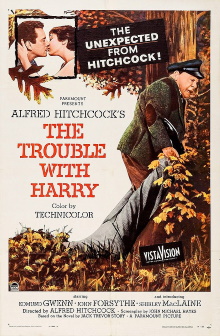This film is mostly interesting as being of the very few comedies directed by Alfred Hitchcock. In keeping with the reputation and style of the legendary director, the plot still revolves entirely around what to do with a corpse. It’s amusing enough but it’s not laugh out loud funny and the plot is predictable once you understand what Hitchcock is going for. The colors of the fall foliage were so vivid I thought it must have been colorized after the fact but it seems that this was exactly the look Hitchcock wanted. As usual, the director’s execution is impeccable but this one is probably worth watching only for committed fans.
In a small town in Vermont, retired boat captain Wiles is out hunting with his rifle and lets off a few shots. When he goes to retrieve the rabbit that he thinks he has shot, he finds instead the corpse of a stranger. He resolves to dispose of the corpse to cover up the crime but then a succession of townspeople just happen to come by. He convinces the unmarried but getting on years Miss Gravely that it was an accident and she agrees that it is better not to involve the police. A tramp comes by and steals the dead man’s shoes but otherwise does nothing. When boy who had earlier found the corpse brings his mother Jennifer Rogers, she declares that he was her husband and seems pleased that he is dead. Eventually local painter Sam Marlowe comes along and after hearing about everything decides to help Wiles bury the corpse. This doesn’t prove to be so easy as the two realize that Wiles may not have killed the man after all. Meanwhile romance kindles between Wiles and Gravely as well as between Marlowe and Rogers.
The schtick here is pretty obvious and frankly not that interesting. The gag of Wiles and Marlowe being forced to bury and rebury the same corpse repeatedly isn’t that funny and it’s kind of silly that Hitchcock thought that this was enough to carry a feature film. It is amusing however as everyone in the town seemingly has no sympathy for the dead man at all and considers covering up his death to be perfectly reasonable and normal. It gives the small town with its inhabitants a low-key creepy vibe especially when you consider some of the other details, such as Rogers’ son toting around the dead rabbit like it’s a toy and Marlowe painting the dead man’s face. Then there’s the scene where Marlowe and Rogers meet one another for the first time and he immediately declares that he wants to paint her nude. Instead of being outraged, she behaves as if it’s no big deal. This was considered explicit for the 1950s and I believe was deliberately meant to contribute to the sense that this is one weird town.
The vivid fall colors of the town contribute to its surrealism. Indeed Hitchcock was so set on the trees being so luxuriant in these specific hues that he had extra leaves glued onto the branches. These bright colors are matched by the clothes worn by the characters as well as the portrait that Marlowe paints and personally commissioned by Hitchcock himself, and all point towards how deliberate the director’s vision of the film was. All the same, creepy as the film is, it’s not enough to elevate the film to greatness. Indeed it’s silly how far the film goes to reach for a happy ending for the characters including having a random rich man appear to give everyone what they want. It’s a novelty film that might interest fans of Hitchcock who are curious about what he might make outside of his usual thrillers but it’s really not that good.
